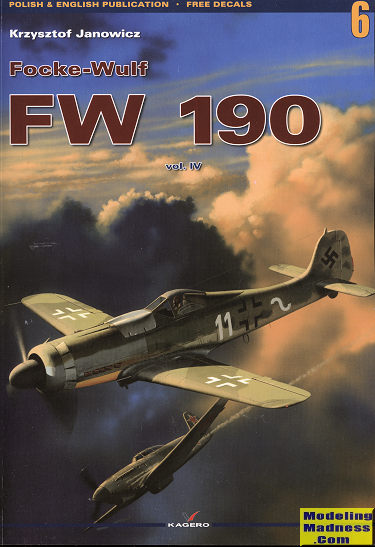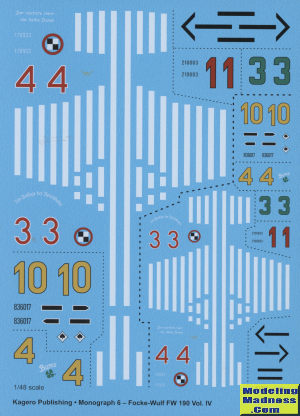Kagero's Focke-Wulf 190 Vol IV
 The FW-190A
was an excellent day fighter that was capable of outclassing its opposition when
it was initially brought into service. However, it was pretty much a low level
fighter and with the introduction of the US into the war with its higher flying
B-17 and B-24 bombers, it was realized that a version capable of attacking at
higher altitudes was needed. Basically, this meant an airplane with a
supercharged or turbocharged engine and for the Germans, that meant one with a
liquid cooled engine.
The FW-190A
was an excellent day fighter that was capable of outclassing its opposition when
it was initially brought into service. However, it was pretty much a low level
fighter and with the introduction of the US into the war with its higher flying
B-17 and B-24 bombers, it was realized that a version capable of attacking at
higher altitudes was needed. Basically, this meant an airplane with a
supercharged or turbocharged engine and for the Germans, that meant one with a
liquid cooled engine.
Getting there was a difficult chore as
this required basically a new engine. Both Daimler-Benz and Junkers were working
on new power plants and so they offered preproduction versions to Focke-Wulf to
test in their new planes. First thing was that the engines were heavier than the
radial engine used in the A model versions. This required an extension of the
fuselage to provide the proper center of gravity. Secondly, it was found that
the Daimler-Benz engine was simply not reliable enough, so the choice of the
Junkers Jumo engine was made. There was still the issue of the boosting, but
eventually a reliable system was developed that fit behind the engine in the
accessory area.
The new FW-190D entered service in late
1944, and while it was a major improvement over the FW-190A, it was a 'too
little - too late' sort of thing. Rarely was the aircraft allowed to intercept
bombers, being used as airfield protection aircraft for Me-262s, though when it
was able to engage enemy fighters, it did quite well. From the 190D was
developed the long wing, high altitude Ta-152 series, but those were only built
in small numbers before the war came to an end.
 Like other Kagero Monographs, this
edition covers the initial development of the 190D-9 and Ta-152C/H along with the
modifications made to the airframe to produce the different variants. Its war
history is also provided, giving a good feel for how well the aircraft did in
different situations. One of the major draws to this series are the large number
of scale drawings of the aircraft. These include fuselage sections and views of
the sides, upper and lower images and fore/aft drawings. Two additional sheets
are provided to cover views that are too large for the book itself.
Like other Kagero Monographs, this
edition covers the initial development of the 190D-9 and Ta-152C/H along with the
modifications made to the airframe to produce the different variants. Its war
history is also provided, giving a good feel for how well the aircraft did in
different situations. One of the major draws to this series are the large number
of scale drawings of the aircraft. These include fuselage sections and views of
the sides, upper and lower images and fore/aft drawings. Two additional sheets
are provided to cover views that are too large for the book itself.
This edition is a reprint of the 2004
dual language release and includes decals, a feature that was often included in
the early releases. There are unique markings for several aircraft and these are
all portrayed in the selection of full color profiles that are a feature of all
Kagero monograph books. Add to this a large
number of period photos and you have a book that thoroughly covers the subject. A great
addition to this series and a book that I have no trouble recommending to you.
May 2022
Copyright ModelingMadness.com. All rights reserved. No
reproduction in part or in whole without express permission.
My thanks to
Casemate Publishing for the review sample.
You can get your copy of this book now
at this link.
If you would like your product reviewed fairly and
fairly quickly, please contact the editor or see other details in the
Note to
Contributors.
 The FW-190A
was an excellent day fighter that was capable of outclassing its opposition when
it was initially brought into service. However, it was pretty much a low level
fighter and with the introduction of the US into the war with its higher flying
B-17 and B-24 bombers, it was realized that a version capable of attacking at
higher altitudes was needed. Basically, this meant an airplane with a
supercharged or turbocharged engine and for the Germans, that meant one with a
liquid cooled engine.
The FW-190A
was an excellent day fighter that was capable of outclassing its opposition when
it was initially brought into service. However, it was pretty much a low level
fighter and with the introduction of the US into the war with its higher flying
B-17 and B-24 bombers, it was realized that a version capable of attacking at
higher altitudes was needed. Basically, this meant an airplane with a
supercharged or turbocharged engine and for the Germans, that meant one with a
liquid cooled engine.  Like other Kagero Monographs, this
edition covers the initial development of the 190D-9 and Ta-152C/H along with the
modifications made to the airframe to produce the different variants. Its war
history is also provided, giving a good feel for how well the aircraft did in
different situations. One of the major draws to this series are the large number
of scale drawings of the aircraft. These include fuselage sections and views of
the sides, upper and lower images and fore/aft drawings. Two additional sheets
are provided to cover views that are too large for the book itself.
Like other Kagero Monographs, this
edition covers the initial development of the 190D-9 and Ta-152C/H along with the
modifications made to the airframe to produce the different variants. Its war
history is also provided, giving a good feel for how well the aircraft did in
different situations. One of the major draws to this series are the large number
of scale drawings of the aircraft. These include fuselage sections and views of
the sides, upper and lower images and fore/aft drawings. Two additional sheets
are provided to cover views that are too large for the book itself.